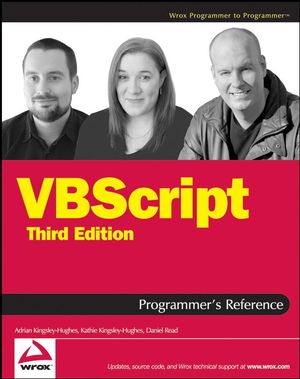VBScript Programmer's Reference, 3rd EditionISBN: 978-0-470-16808-0
Paperback
816 pages
October 2007
 This title is out-of-print and not currently available for purchase from this site.
|
Acknowledgments xi
Introduction xxv
Chapter 1: A Quick Introduction to Programming 1
Variables and Data Types 2
Flow Control 9
Operators and Operator Precedence 18
Organizing and Reusing Code 19
Top-Down versus Event-Driven 23
Coding Guidelines 25
Summary 29
Chapter 2: What VBScript Is — and Isn’t! 31
Windows Script 31
Version Information 32
VBScript Is a Subset of VB 32
VBScript Is a Scripting Language 33
VBScript Is Interpreted at Runtime 33
Advantages of Using VBScript 36
Is VBScript Right for You? 37
How VBScript Fits in with the Visual Basic Family 38
What Can You Do with VBScript? 40
Tool of the Trade — Tools for VBScript 43
Summary 44
Chapter 3: Data Types 45
Scripting Languages as Loosely Typed 46
Why Data Types Are Important 47
The Variant: VBScript’s Only Data Type 49
Arrays as Complex Data Types 72
Summary 81
Chapter 4: Variables and Procedures 83
Option Explicit 83
Naming Variables 85
Procedures and Functions 86
Variable Scope, Declaration, and Lifetime 95
Design Strategies for Scripts and Procedures 99
ByRef and ByVal 101
Literals and Named Constants 104
Summary 108
Chapter 5: Control of Flow 109
Branching Constructs 109
Loop Constructs 114
Summary 128
Chapter 6: Error Handling and Debugging 129
Types of Errors 130
Error Visibility and Context 137
Handling Errors 139
Generating Custom Errors 152
Debugging 157
Summary 181
Chapter 7: The Scripting Runtime Objects 183
What Are Runtime Objects? 183
Object Basics 184
The Dictionary Object 190
The FileSystemObject Library 196
Summary 207
Chapter 8: Classes in VBScript (Writing Your Own COM Objects) 209
Objects, Classes, and Components 209
The Class Statement 211
Defining Properties 212
Defining Methods 218
Class Events 220
Class-Level Constants 222
Building and Using a Sample VBScript Class 223
Summary 232
Chapter 9: Regular Expressions 233
Introduction to Regular Expressions 233
The RegExp Object 238
The Matches Collection 252
A Few Examples 256
Summary 259
Chapter 10: Client-Side Web Scripting 261
Tools of the Trade 261
The Evolution of Scripting 262
Different Scripting Languages 263
Responding to Browser Events 265
The Document Object Model in Action 280
Summary 286
Chapter 11: Windows Sidebars and Gadgets 287
Gadget Basics 288
Building a Gadget 292
Auto-Refresh a Gadget 305
Packaging the Gadget 307
Summary 307
Chapter 12: Task Scheduler Scripting 309
Working with Task Scheduler 310
Task Scheduler 2.0 Scripting Objects 314
Sample Task Scheduler Script 340
Summary 344
Chapter 13: PowerShell 345
Requirements 345
Features 346
Why a New Scripting Language? 346
Getting Started 347
Working with Scripts in PowerShell 356
Creating and Calling Your First PowerShell Cmdlet Script 357
The Connection Between VBScript and PowerShell? 359
Summary 373
Chapter 14: Super-Charged Client-Side Scripting 375
Requirements and Browser Security 375
Scriptlets — Ancestors of Behaviors 376
Event Management 384
Scriptlets Are Deprecated in IE5 389
HTML Components (HTCs) 392
Summary 402
Chapter 15: Windows Script Host 405
Tools of the Trade 406
What Is WSH? 406
Types of Script Files 408
Running Scripts with the Windows Script Host 408
Using .WSH Files to Launch Scripts 411
Windows Script Host Intrinsic Objects 412
Summary 464
Chapter 16: Windows Script Components 465
What Are Windows Script Components? 465
What Tools Do You Need? 466
The Script Component Runtime 466
Script Component Files and Wizard 467
Exposing Properties, Methods, and Events 473
Registration Information 478
Creating the Script Component Type Libraries 479
How to Reference Other Components 481
Script Components for ASP 482
Compile-Time Error Checking 484
Using VBScript Classes in Script Components 484
Summary 488
Chapter 17: Script Encoding 489
Limitations of Script Encoding 490
Encoded Scripts — Dos and Don’ts 490
Encoding with the Microsoft Script Encoder 491
Decoding the Script 507
Other Methods of Script Obfuscation 507
Summary 508
Chapter 18: Remote Scripting 509
How Remote Scripting Works 509
Using VBScript for Remote Scripting 511
Summary 516
Chapter 19: HTML Applications 517
The Advantage of an HTML Application 517
How to Create a Basic HTA 518
The HTA:APPLICATION Element 522
HTAs and Security 527
HTA Deployment Models 530
What Isn’t Supported with HTAs? 532
Summary 533
Chapter 20: Server-Side Web Scripting 535
Understanding the Anatomy of the HTTP Protocol 536
Introducing Active Server Pages 540
Using the Active Server Pages Object Model 544
Using Active Server Pages Effectively 559
Summary 567
Chapter 21: Adding VBScript to Your VB and .NET Applications 569
Why Add Scripting to Your Application? 570
Macro and Scripting Concepts 570
Adding the Script Control to a VB 6 or .NET Application 572
Script Control Reference 573
Error Handling with the Script Control 592
Debugging 595
Using Encoded Scripts 596
Sample .NET Project 596
Sample Visual Basic 6 Project 597
Summary 602
Appendix A: VBScript Functions and Keywords 603
Appendix B: Variable Naming Convention 675
Appendix C: Coding Conventions 677
Appendix D: Visual Basic Constants Supported in VBScript 681
Appendix E: VBScript Error Codes and the Err Object 687
Appendix F: The Scripting Runtime Library Object Reference 703
Appendix G: The Windows Script Host Object Model 715
Appendix H: Regular Expressions 723
Appendix I: The Variant Subtypes 727
Appendix J: ActiveX Data Objects 731
Index 759



